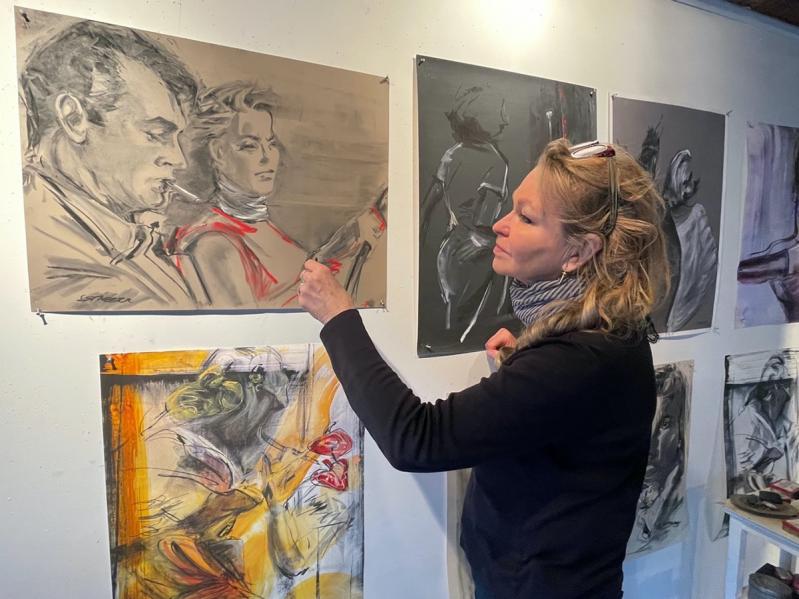The Sag Harbor artist Sabina Streeter has a longstanding connection to Douglas Sirk, a German-born film director known for such widely admired 1950s Hollywood melodramas as "All That Heaven Allows," "Written on the Wind," "Imitation of Life," and "The Tarnished Angels."
"Tarnished Angels: Douglas Sirk's America," a mini-retrospective that includes those titles plus Todd Haynes's "Far From Heaven," a 2002 film shot in the Sirkian style, will open on Friday at the Sag Harbor Cinema with "The Tarnished Angels," a drama starring Rock Hudson, Dorothy Malone, and Robert Stack.
Organized by Giulia D'Agnolo Vallan, the cinema's founding artistic director, the program was conceived in conjunction with an exhibition of paintings by Ms. Streeter inspired by frames of Sirk's films.
"I always loved the heartbreak and the irony behind Sirk’s beautifully stylized '50s melodramas," said Ms. Vallan -- "his heightened use of color and design, his brilliance with light and sound, and the quiet doom that haunts his characters."
Sirk began his career in the theater, but after the Nazis came to power, he and his wife, Hilde, who was Jewish, fled Germany for the United States. He worked for Columbia Pictures in the early 1940s, returned to Germany briefly after the war ended, and came back to Los Angeles to establish his reputation as a director for Universal-International Pictures between 1952 and 1959.
"The Tarnished Angels," set in 1932 New Orleans and based on William Faulkner's largely forgotten novel "Pylon," is "among Sirk’s most self-conscious and artistically ambitious creations, a relentlessly bleak and disturbing work about the erotic attraction of death," wrote the film critic Dave Kehr.
Starring Jane Wyman and Rock Hudson, "All That Heaven Allows" (1955) explores the social complications that arise following the development of a romance between a well-to-do widow and a younger man, the owner of a tree nursery.
"Written on the Wind" (1956), a Southern Gothic melodrama, follows the troubled members of a Texas oil dynasty in what Mr. Kehr called "a screaming Brechtian essay on the shared impotence of American family and business life." It stars Lauren Bacall, Robert Stack, Dorothy Malone, and Hudson.
"Imitation of Life" (1959) features Lana Turner as a young widow and mother who will do anything to realize her dream of Broadway stardom. The highest grossing film in Universal's history until "Airport" (1970), it tackled issues of race, class, and gender.
After the success of "Imitation of Life," which received Oscar, Golden Globe, and Directors Guild nominations, Sirk left the United States and settled in Lugano, Switzerland, where he began to work again in the theater.
Ms. Streeter's parents met Sirk in the 1960s, when her mother, a documentary filmmaker, was making a film about the expatriate community in Pacific Palisades, Calif. They became close friends. Years later, as an art student in Munich, Ms. Streeter went with Sirk to meetings with Rainer Werner Fassbinder, an important figure of the New German Cinema. An enthusiastic review in Cahiers du Cinema of Sirk's "A Time to Love and a Time to Die" by Jean-Luc Godard, helped bring him to the attention of young filmmakers.
In 2018, Ms. Streeter was approached by the Berlin Film Festival to show her art there in connection with the festival. "I always wanted to do something with Sirk's stills, and I had been working all my life with film references." The exhibition opened in Berlin the following year. After a pandemic hiatus, it went to Munich in 2021.
April Gornik connected Ms. Streeter to Ms. Vallan, who proposed installing Ms. Streeter's artwork on the cinema's third floor during the retrospective. The Sag Harbor show is the first time her Sirk paintings have been paired with his films.
Ms. Streeter's work begins with photographs taken from the films from a computer screen. Most are made with charcoal and pastel, though some are oil paintings. "I try to stay, in my paintings, in his color range, which has these gray-blues, or he uses reds as accents. I also try to be more impressionistic, more gestural, so that it's not just painting directly from the still."
Sirk's films will run from tomorrow through Wednesday. Mr. Haynes's "Far From Heaven," the story of a 1950s housewife in suburban Connecticut who sees her life falling apart, will be shown Saturday at 5 p.m. in a 35mm print. Ed Lachman, who shot the work in the style of Sirk's melodramas, will be on hand for a conversation after the screening, and a reception for Ms. Streeter's exhibition will follow from 7 to 9 on the third floor.




